MAJOR FINDINGS
Nutrients in Ground Water and Streams
Two naturally occurring nutrients, nitrogen and phosphorus, commonly are applied in the form of fertilizers and manure in agricultural areas to increase the yield of crops and as fertilizer in cities and towns to enhance the appearance of residential lawns, city parks, and golf courses. Nitrogen and phosphorus also are commonly discharged from wastewater-treatment facilities. Nutrients that are not used by plants or attached to soil particles can move to shallow ground water or can be washed into nearby streams during intense rains. Runoff from rainfall and ground-water inflow can transport excess nutrients to streams, causing algal blooms that deplete oxygen for fish and other aquatic organisms. High concentrations of nitrogen in the form of nitrate may make untreated water unsuitable for human consumption. The USEPA has established a Maximum Contaminant Level (MCL) of 10 mg/L (milligrams per liter) for nitrate as nitrogen in drinking water (U.S. Environmental Protection Agency, 1996). High concentrations of nitrogen in the form of ammonia may kill fish and other aquatic organisms. To minimize algal growth in streams and reservoirs, a total phosphorus concentration of 0.10 mg/L or less has been recommended by the USEPA (1986).
Nutrients in Ground Water
Nitrogen and phosphorus are prevalent in ground water. Nitrogen readily moves from the land surface to ground water in the shallow alluvial aquifers but not as readily to most parts of the deeper Silurian-Devonian and Upper Carbonate bedrock aquifers in the Eastern Iowa Basins. Nitrogen, in the form of nitrate and ammonia, and dissolved phosphorus were detected in more than 65 percent of 124 ground-water samples. Nitrate concentrations were significantly higher in the shallow alluvial aquifers, which have been identified as being susceptible to contamination (Hoyer and Hallberg, 1991), than in the Silurian-Devonian and Upper Carbonate bedrock aquifers (fig. 6). Nitrate concentrations in water samples from monitoring wells screened near the water table in urban areas were higher than concentrations in samples from domestic wells, which generally are screened deeper in the aquifers.
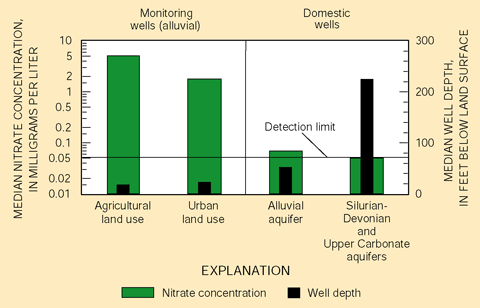 |
| Figure 6. The shallowest ground water is most heavily affected by current land-use practices. Agricultural practices result in higher levels of nitrate in ground water than urban activities. |
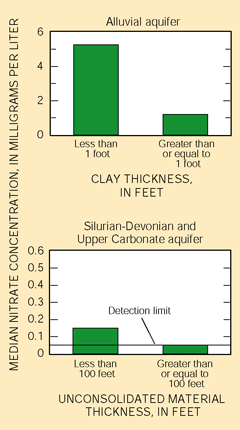 |
| Figure 8. Overlying clay and other low-permeability material hinder movement of nitrate to ground water. |
Human and natural factors affect movement of nutrients to ground water. Downward movement of water containing nitrogen and phosphorus is slowed by fine-grained materials overlying the aquifers. The presence of clay in the soil and in the shallow subsurface and low-permeability rocks, such as shale, can slow ground-water infiltration rates and limit the amount of nutrients at depth. Surficial contamination most affects water near the top of the alluvial aquifers where the clay layer above the water table is thin or nonexistent (fig. 8).
In the Silurian-Devonian and Upper Carbonate aquifers, ground-water ages (determined by analysis of tritium concentrations) were significantly younger and nitrate concentrations were significantly higher in samples from areas where an overlying low-permeability shale layer was absent or where less than 100 feet of unconsolidated deposits overlies the aquifer (Savoca and others, 1999). These two results indicate that longer flow paths (deeper sample depth and thicker clay layer) increase opportunities for sorption, degradation, and dispersion and may contribute to decreases in nutrient concentrations with depth. Alternatively, water deeper in the aquifer may have infiltrated in years when fertilizer use was not as prevalent.
Natural processes may remove nitrogen from alluvial aquifers. The relation between nitrogen, dissolved oxygen, and organic carbon concentrations suggests that nitrogen is being biologically transformed and removed from the alluvial aquifers. Nitrate remaining after water moves through or around clay layers may be converted to nitrogen gas in a low-oxygen or oxygen-free environment in the presence of organic carbon. This process is called denitrification. Nitrate concentrations were significantly higher in alluvial ground water having dissolved oxygen concentrations greater than 0.5 mg/L and were significantly lower in ground-water samples having increased dissolved organic carbon concentrations (Savoca and others, 2000). Denitrification may be an important natural process that reduces nitrate concentrations before water moves to ground-water supplies or is discharged to streams.
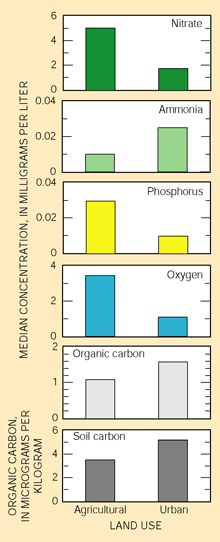 |
|
| Figure 9. Agricultural and urban land uses contribute nitrogen to shallow alluvial aquifers. Conditions are suitable in urban areas for the formation of ammonia in the organic- enriched aquifers. |
The type of land use affects shallow ground-water quality. Different uses, whether the land is used for agriculture, homes, business, or industry, are reflected in the nutrient concentrations in the ground water. Animal feeding operations can further affect water quality in areas with intensive row-crop agriculture (fig. 9). Nitrate was detected more frequently (94 percent of samples) and in greater concentrations (median of 5.1 mg/L) in shallow alluvial aquifers in agricultural areas than in urban areas. Nitrate was detected in 77 percent of samples at a median concentration of 1.8 mg/L from urban areas (fig. 6). Nitrate exceeded the USEPA MCL (10 mg/L as N) in 39 percent of samples from agricultural areas and in none of the samples from urban areas. Dissolved phosphorus concentrations tended to be higher in samples from agricultural areas (median of 0.03 mg/L) than urban areas (median of 0.01 mg/L); however, the difference was not statistically significant. The higher reliance on fertilizers in agricultural areas than in urban areas most likely contributed to the higher nitrate and phosphorus concentrations.
Ammonia is prevalent in shallow urban ground water. Dissolved ammonia concentrations were significantly higher in samples from urban areas than in samples from agricultural areas (fig. 9). The median dissolved ammonia concentration in samples from shallow urban ground water (0.025 mg/L) was more than twice the median concentration in samples from agricultural areas (0.010 mg/L). Anhydrous ammonia is used frequently as a nitrogen fertilizer for corn, but soil microbes quickly convert ammonia to nitrate.
Conditions in the alluvial aquifers (fig. 9) indicate that ammonia in shallow urban ground water originates, at least partly, from degradation of organic matter most likely derived from human activities. Substantial amounts of organic matter are available in the soil, silt, and clay above the aquifer and dissolved in water within the aquifer. Dissolved oxygen concentrations were significantly lower in urban areas than in agricultural areas. Microbial degradation of abundant organic matter would result in the decrease in dissolved oxygen concentrations and in the increase of dissolved ammonia concentrations in shallow ground water.
Nutrients move from ground water to streams by natural drainage and tile lines. At times, ground water contributes a substantial amount of nitrogen to streams in the Eastern Iowa Basins Study Unit. In most parts of the Study Unit, water naturally flows from alluvial aquifers to streams through the streambanks and streambeds. During high base flow in May 1998, nitrate concentrations in samples from 24 of 25 streams in the Eastern Iowa Basins were higher than 10 mg/L. In contrast, nitrate concentrations in these streams ranged from less than 0.05 to 8.3 mg/L during low base flow in August 1997. The high concentrations detected during the spring may be due to the increased ground-water inflow after fertilizer was applied and was readily available for transport.
Shallow tile lines have been installed to remove excess water from the land and to lower the water table in many parts of the Study Unit. These tile lines typically drain water from the upper part of the water table, which generally contains the highest nitrate concentrations to nearby streams. During the summer, the water table may decline below the tile lines due to decreased rainfall and increased evapotranspiration. Tile-line flow and nutrient transport then cease. For example, nitrate concentrations were consistently higher than 10 mg/L in tile-line discharge from April until the end of August when flow in this and other local tile lines ceased (fig. 10). After tile flow ceased, nitrate concentrations in the Iowa River decreased.
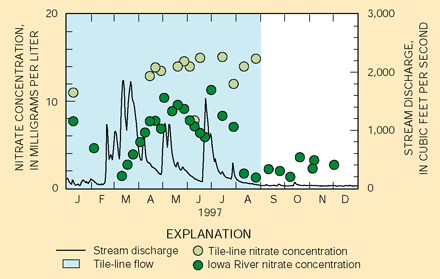 |
| Figure 10. Tile lines can contribute substantial amounts of nitrate to streams and rivers. Nitrate concentrations in the Iowa River near Rowan decreased as tile-line discharge ceased. |
When tile flow ceases, streamflow originates from natural ground-water inflow, which traverses deeper and longer flow paths. Water that originates from deep in the alluvial aquifers contains low nitrate concentrations (see previous discussion) due to transformation in the aquifer or streambed and plant uptake as it passes beneath riparian buffers. These results are similar to those of previous studies (Cambardella and others, 1999; Soenksen, 1996) that documented the importance of tile-line discharge on stream-water quality.
Increased algal growth in late summer and early fall also can contribute to decreased nitrate concentrations in streams (Porter, 2000). Tile-line drainage is an important hydrologic factor that may serve to protect shallow ground water by removing contaminants before they move down into the aquifers; however, tile lines also may enhance the contamination of streams by short circuiting natural processes that remove nitrogen from ground water.
Nutrients in Streams
The concentrations of nutrients in a stream or river are the result of the interaction of human activities and natural factors in the basin. Human activities, agricultural and urban, generally increase the input of nitrogen and phosphorus into the basin, alter the land surface and drainage patterns (which may affect the amount and timing of rainfall runoff), and alter vegetation on the land and habitat in streams and rivers, resulting in a more rapid flushing of nutrients from the land and downstream in streams and rivers. Natural factors including the amount and timing of rainfall, soil types, and land-surface slope affect the amount of nitrogen and phosphorus washed off fields into nearby streams.
Nitrogen and phosphorus are almost always present in streams and rivers. Nitrate, the most common form of nitrogen in streams and rivers in the Eastern Iowa Basins, was present in more than 98 percent of the samples at concentrations of 0.05 mg/L or greater and was most frequently (80 percent of the samples) present in the range of 1 to 10 mg/L (fig. 11). Nitrate concentrations less than about 0.5 mg/L were generally associated with low streamflow in late summer when nitrogen inputs were low and algal uptake was high. About 22 percent of the samples (fig. 12) contained nitrate concentrations at or above the USEPA's drinking-water standard of 10 mg/L (U.S. Environmental Protection Agency, 1996).
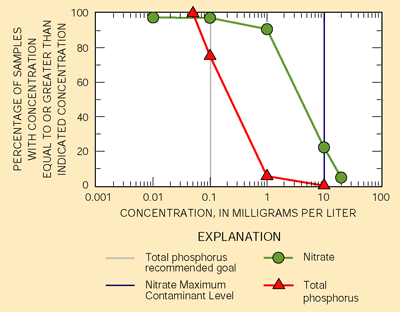 |
| Figure 11. Nitrate concentrations in streams were most often in the range of 1 to 10 mg/L and equaled or exceeded the Maximum Contaminant Level in 22 percent of the samples. In contrast, total phosphorus concentrations equaled or exceeded the 0.1-mg/L goal for minimization of algal growth in 75 percent of the samples. |
Phosphorus, dissolved in the stream water and attached to sediment particles or organic compounds transported in the stream, was present in all samples. Total phosphorus concentrations exceeded the USEPA goal of 0.1 mg/L (U.S. Environmental Protection Agency, 1986) or less to minimize plant and algal growth about 75 percent of the time. Streams with large total phosphorus concentrations generally contained large suspended-sediment concentrations.
Landform and land use affect nitrogen and phosphorus concentrations. Nitrogen and phosphorus concentrations in streams differed among landform areas and with land use (fig. 12). Basins of the size investigated during this study where human activities are minimal (background) are not present in eastern Iowa and southern Minnesota. The Wapsipinicon River near Tripoli was identified as a reference site, however, because although agricultural land use constitutes more than 90 percent of the basin, substantial areas of riparian forests and wetlands remain. Samples from the reference site generally had the lowest median nutrient concentrations of any stream site studied. Median suspended-sediment concentrations also were the lowest. Biological indicators of water quality at the reference site were better than all other sites in the Study Unit. Extensive flood-plain vegetation may decrease direct transport of nutrients from fields to the Wapsipinicon River, and extensively wooded banks on the nonchannelized river may decrease streambank erosion and enhance biological habitat.
 |
|
| Figure 12. Nitrate concentrations generally were lower in large rivers than in smaller streams. In contrast, total phosphorus concentrations were greater in large rivers than in streams. (Site number in parentheses; see site map in Study Unit Design section. AFO is animal feeding operation.) |
Median nitrate concentrations were highest in samples from Wolf Creek, a stream draining an Iowan Surface basin that has more than 80-percent row-crop agriculture, and in samples from the South Fork Iowa River, a stream draining a Des Moines Lobe basin that has concentrated animal-feeding operations (AFO). The median nitrate concentration in samples from Wolf Creek (10.2 mg/L) exceeded the 10-mg/L USEPA MCL. Algal status and biomass in Wolf Creek indicated degraded conditions (from a national perspective), and fish and invertebrate communities were dominated by species tolerant to nutrient and organic enrichment. Wolf Creek flows into the upper end of a reach of the Cedar River that has been listed on the 1998 USEPA Section 303(d) list (Iowa Department of Natural Resources, 2000) as an impaired water body. Wolf Creek may provide substantial amounts of nitrogen that contribute to the degradation of the Cedar River between Waterloo and Cedar Rapids.
Landform features affect phosphorus concentrations. Phosphorus and suspended-sediment concentrations were typically larger in streams that drain the Southern Iowa Drift Plain and the Des Moines Lobe than in other streams. The Southern Iowa Drift Plain typically has steeper slopes than the rest of the Study Unit and contains loess deposits that are easily eroded (Schwarz and Alexander, 1995). Many Des Moines Lobe streams have been extensively channelized; to a great extent, the streambanks and flood plains contain little riparian vegetation, resulting in a greater dominance of phytoplankton than benthic algae and relatively higher rates of stream metabolism that can influence dissolved-oxygen conditions during base-flow conditions (Porter, 2000).
Intensive row-crop agriculture contributes to greater nitrate concentration. The intensity of row-crop agriculture is partly responsible for the variability of nitrate concentrations in streams. Typically, streams in basins that have a higher percentage of corn and soybeans and less pasture, forest, and CRP (Conservation Reserve Program) acres had higher total nitrogen concentrations (fig. 13). However, large rivers in basins that had a slightly lower percentage of row crops and a slightly larger proportion of urban areas typically had higher total phosphorus concentrations. Large rivers generally contained higher suspended-sediment concentrations than streams, and most large potential point-source phosphorus contributors (large cites) are located on the large rivers.
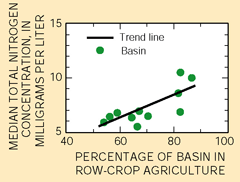 |
| Figure 13. Streams draining basins that have higher percentages of pasture, grassland, and forests and less land planted in row crops tended to have lower nitrogen concentrations. |
Increased availability results in greater nutrient concentrations during the spring and early summer. Concentrations of nitrogen and phosphorus varied seasonally in streams in eastern Iowa (fig. 14). Median total dissolved nitrogen concentrations were highest in June (11.5 mg/L) when nitrogen is transported to streams and rivers by spring and early summer runoff from rainfall. Nitrogen probably originates from that accumulated in the soil following application of chemical fertilizers and manure during the spring and previous fall. Nitrate was the predominant form of nitrogen detected during this period. Total dissolved nitrogen concentrations in streams decreased through the summer as nitrogen was removed from the soil by plant uptake, runoff, and leaching to shallow ground water. Algal and plant growth in the streams during low streamflow in late summer and early fall can result in increased uptake of dissolved nutrients (Porter, 2000). The combination of reduced source loading and instream processing results in lowest nitrate concentrations in October. Fall rains, in combination with fertilizer and manure applications, were associated with another rise in nitrogen concentrations beginning in November and peaking in January. Although nitrate remained the primary form of nitrogen, ammonia and organic nitrogen were more prevalent during the winter.
Runoff from agricultural and urban areas transports substantial amounts of phosphorus to streams, but the timing of peak phosphorus concentrations does not always correspond to peak nitrate concentrations. Phosphorus concentrations peak during periods of high runoff in early spring when substantial amounts of soil are eroded into the streams. The highest median total phosphorus concentrations occurred in February (0.33 mg/L) and March (0.36 mg/L) with a secondary peak in June (0.29 mg/L) (fig. 14). Maximum concentrations corresponded with early seasonal runoff from snowmelt or rainfall. Early summer rains produced runoff that accounted for a secondary peak in total phosphorus concentrations during June.
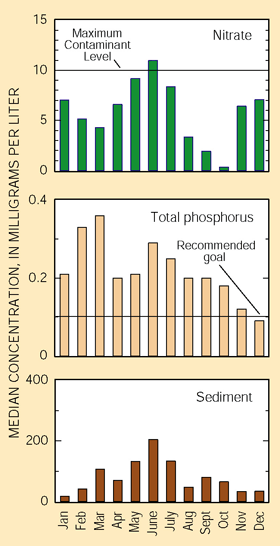 |
| Figure 14. Nitrate concentrations that commonly increase to levels that exceed the Maximum Contaminant Level in June can decrease to levels below detection in October. Total phosphorus concentrations were rarely below the recommended goal for reduction of algal growth. |
| ANIMAL FEEDING OPERATIONS CONTRIBUTE ADDITIONAL NUTRIENTS TO STREAMS The median nitrate concentration in samples from the South Fork of the Iowa River (9.5 mg/L) were significantly higher than those in samples from the Iowa River near Rowan (median of 6.3 mg/L), though both streams drain the same landform (Des Moines Lobe) and have similar crop patterns (greater then 80 percent row crops). In addition to row-crop agriculture, the basin of the South Fork Iowa River contains substantially more permitted animal feeding operations (AFO) (29) than the Iowa River Basin upstream from Rowan (8). The density of hogs (fig. 15) in the South Fork basin is more than twice that in the Iowa River Basin (Sorenson and others, 1999). The manure generated from AFOs is commonly applied on fields in substitution for chemical fertilizer. However, in areas where there is dense concentration of AFOs, sufficient land may not always be available to economically dispose of animal wastes, and the potential for overapplication exists. Excess nutrients seep into the ground water and are washed into nearby streams. About 1.8 times more nitrogen and about 2.5 times more phosphorus were transported by the South Fork Iowa River than by the Iowa River (fig. 15). The higher nitrate concentrations and the greater nitrogen and phosphorus yields from the South Fork Iowa River compared to the Iowa River near Rowan may indicate that a reduction in chemical fertilizer application equivalent to the increased manure application has not occurred in the South Fork Basin.
|
Transport of nutrients represent an economic loss and a potential environmental threat. The large amounts of nitrogen and phosphorus that are transported from the Study Unit by the Wapsipinicon, Cedar, Iowa, and Skunk Rivers represent an economic loss to farmers and an environmental concern for downstream water.
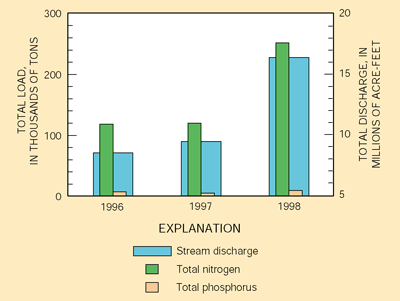 |
| Figure 16. Increased streamflow from 1996 to 1998 resulted in larger amounts of nitrogen and phosphorus transported from the Study Unit to the Mississippi River. |
Nitrogen and phosphorus transported to the Mississippi River increased yearly from 1996 through 1998 (fig. 16). Increased streamflow was a major factor in the increased loads. The estimated mass of nitrogen (load) increased from about 106,000 tons in 1996 to more than 257,000 tons in 1998, and the estimated total phosphorus load increased from 7,500 tons in 1996 to 9,700 tons in 1998.
Transport of nutrients from the Eastern Iowa Basins represents a potential loss in crop yield or the cost of additional fertilizer needed to compensate for that flushed from the fields. Nutrient loads transported from the Eastern Iowa Basins represent an average loss of 17 lb/acre/year of nitrogen and 1.2 lb/acre/year of phosphorus in 1996 and 42 lb/acre/year of nitrogen and 1.6 lb/acre/year of phosphorus in 1998.
Iowa, including the Eastern Iowa Basins, has been identified as a major source of nutrients (Goolsby and others, 1999) that contribute to eutrophication and hypoxia in the Gulf of Mexico (Rabalais, 1996). Alexander and others (2000) estimated that more than 90 percent of the nitrogen reaching the Mississippi River from the Eastern Iowa Basins is transported to the Gulf of Mexico.
| Table of Contents || Previous Section || Next Section || Glossary U.S. Geological Survey Circular 1210 Suggested citation:
|


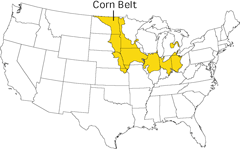
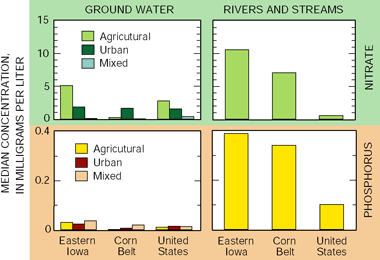
![Figure 15. Large-scale hog production adds to the nitrogen and phosphorus in streams draining basins in the Des Moines Lobe landform. [Hog density data calculated from Iowa Department of Natural Resources (1999) waste-control facility permits.]](images/eib_fig15.gif)
